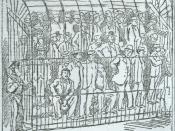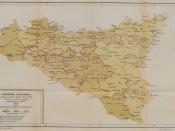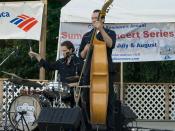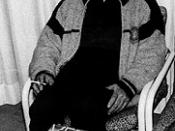In Sicily, the Mafia is such an important part of the daily life of every citizen and it is so entrenched in the social, spiritual, and political ways of life that there is an incredibly strong link between crime, personal politics and cultural identity. In T"o Each His Own", Sciascia explores the dichotomy of appearance versus reality through an extended metaphor that deals with the pharmacistÃÂs hunting dogs. The inability of the dogs to retell the story of the killings, despite being witnesses to them, mimics the concept of omertà that infiltrates the mafia culture of the town, with the townspeople knowing the details but refusing to speak of the killings. The question of how an issue appears compared to the reality of the situation explores how the Mafia manages to sustain itself through an absence of standards or values within societyÃÂs individuals and reveals SciasciaÃÂs belief that it is impossible to defeat the Mafia.
Part of the foundation of the Mafia culture is the code of silence called ÃÂomertà àdesigned to protect all of those involved in mafia dealings. The goal is to trick authorities and the public into believing that a person has no knowledge of a certain instance by witholding facts and evidence so as to avoid implication of ÃÂprotectedàpeople. This opposition of appearance and reality permeates SciasciaÃÂs story from the first sentence of To Each His Own; the letter delivered to the pharmacist is a diversion, a falsity that displays Manno the pharmacist as the target of the subsequent murder and Roscio as an innocent victim. The rest of the townspeople also begin to gather knowledge about the true nature of the killings that ensue just days later, yet maintain a strict code of silence when questioned by the carabinieri. As Don Luigi puts it, ÃÂWhat good does it do to talk?...What I know, you know and everyone else knowsà(Sciascia 153). Unfortunately, because ÃÂthe codeàis so strong, these details are only revealed as the story progresses; Sciascia does however give a foretelling glimpse of the plot with the metaphor of the hunting dogs noisely returning to town.
Sciascia tells that after Manno the pharmacist and Roscio the doctor are killed, their (remaining) dogs flee and returned, ÃÂrunning in close ranksàto the center of the village back to the one dog left behind. ÃÂThereàthey redoubled their howls, no doubt communicating to their comradeànews of the tragic happeningà(14). This implies that the dogs bore witness to the killings and had the knowledge of how eveything happened and who carried out the brutal act. It also appears that the dogs are trying to communicate the events with the town yet they do not understand how to communicate their knowledge and the townspeople can not understand them. This appearance is incorrect however, and the reality is the dogs may know the details of their mastersàdeaths but will not reveal them to anyone outside their social circle. Instead, the dogs ÃÂsee this fingeràand choose to ÃÂbite ità(158). This is an example that the code of omertà is so entrenched within Sicilian society, it applies to every level, even that of the dogs.
Sciascia states ÃÂthat even had they had the gift of speech, the dogs would have become so many mutes both with regard to the identity of the murderers and in testifying before the marshal of the carabinierià(14). The barking is meant to be foreign to the people and known only among the dogs; the townspeople would never speak of murders and mafia-related dealings with the police and discussed events only with each other, as a form of gossip. This parallels the notion that peasants who witnessed horrific Mafia-related crimes often replied to police questions with responses similar to ÃÂI didnÃÂt hear anything,àor ÃÂI was working all day and never saw another person.àThis is because a significant portion of omertà is not just about refusing to report crimes but rather denial when asked questions concerning illegal or mischievous activities. We see this piece of the code when the police marshal ÃÂstood in the square trying to persuade the animals, with tidbits of tripe, exhortations, and haranguings, to lead him to the spot where they had left their masters. But the dogs cared not a bità(15). This gives human qualities to the dogs, as the marshall was trying to communicate with them, yet the communication attempt is one-sided and kept up only by the marshal. In this way, peasants and townspeople are the dogs of daily Sicilian society, speaking in tongues and ways that the carabinieri and police cannot understand.
Like the police and carabinieri, Laurana takes it upon himself to find out why the two men were killed. He questions everyone he believes may have information concerning the two deaths, much like how the marshal attempts to talk to the dogs and get their story. It seems to Laurana that no one knows much at all about Manno or Rosci, yet we learn later that almost everyone knows of the reason for the killings and who was the real target. Don Luigi even admits that he knew the truth ÃÂbefore the three days of mourning were overà(154). In this way, the townspeople are the dogs who will not reveal their knowledge to Laurana and pretend as if they themselves do not understand the reason behind the murders. After all, ÃÂPoor innocents who know nothing, say nothingà(158). The code of omertà runs rampant in this respect, as the townspeople keep the important revealing details to themselves in order to protect their lives.
This typical mafia culture that exists in the book parallels the true Sicilian culture it is based off of. Sciascia implies through his writing that this normal way of life is on a level that is on par with that of animals and having a ÃÂdog-eat-dogÃÂ mentality. The townspeople, peasants, and dogs are all concerning first and foremost with basic survival on the lowest level of life. They all know that to give up a fellow member of society to ÃÂjusticeÃÂ is to have a death wish; instead, it is better to gossip about events and stories ÃÂin half sentences and under their breathÃÂ with those on the same societal level and communicate nothing to authorities (152). This is thus the same as barking and making noise but saying not a word.
Laurana is foreign to this concept of making noise without revealing important details as he is truly on a different level of society. He is an educated man, a professor, and maintains a disconnected relationship to the rest of the townspeople. Laurana is an idealist, and when reading the words that appear from the back of the threatening letter, he ÃÂsaw the word ÃÂUnicuiqueÃÂàand then, ÃÂnatural orderÃÂàand read aloud ÃÂhumanÃÂà(12). No one else is concerned with this, which can mean that Laurana can be considered the only human among the dogs of the town. He cannot relate to the dog culture that surrounds him and is thus alien to this animalistic culture. Laurana believes in reason, candor and the application of intellect to reality as a means to resolution. In an ironic way, his reason and determination do lead to a resolution, yet it is the resolution of his life because he was unable to adapt to the culture around him and to live by the code of omertà .
SciasciaÃÂs novel implies that defeating the mafia is impossible as the townspeople and peasants are too entrenched in the way of keeping to themselves; even the dogs of the town have been brainwashed into not speaking to authority figures. The code of omertà and the alteration of what appears to be true have permeated every level of society. In order to defeat the mafia and change the current state of things, Sciascia suggests that revolutionary tactics would have to alter the entire structure of society, which is near impossible. To do this would require the same amount of difficulty that it would to give a dog the ability to speak in a human tongue, as this can only be given by ÃÂthe order of Creationà(14). Sciascia makes it clear in To Each His Own that dogs will never be able to communicate with humans, downtrodden peasants and simple-minded townspeople will never talk to authorities, and the Mafia will always be a force to be reckoned with in Sicily.
To Each His Own - novel by Leonard Sciascia





